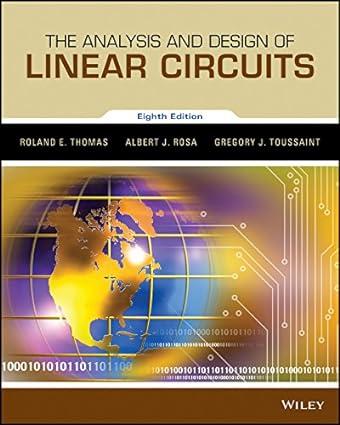Digital signal processing uses samples of an analog waveform, as contrasted with analog processing, which operates on
Question:
Digital signal processing uses samples of an analog waveform, as contrasted with analog processing, which operates on the entire waveform. Sampling refers to the process of selecting discrete values of a time-varying analog waveform for further processing. By far, the most common method of sampling is to record the waveform amplitudes at equally spaced time intervals. The set of samples υkfk = 1,2,3,…g of an analog waveform υðtÞ is defined as υk = υðkTSÞ
where k is an integer and TS the time interval between successive samples. Figure 13–
13 shows an example of sampling an analog waveform.
The digitized samples can be stored in a computer or some other medium such as a compact disc. These samples become the only means of describing the original analog signal. How good of a description can they be? From our experience, we know that a reasonable facsimile can be obtained if the samples are closely spaced. Intuitively, it might seem that exact reconstruction of the analog waveform would require the time between samples to approach zero. Surprisingly, exact reproduction is possible from samples taken at finite intervals.
An analog waveform υðtÞ whose spectral content falls below fmax can be reproduced exactly from samples υk = υðkTsÞ if the sampling rate fS = 1=TS is greater than 2fmax.
This statement, known as the sampling theorem, is one of the key principles of signal processing. The theorem states that exact recovery requires a minimum sampling rate of 2fmax.2 Analog waveforms are usually sampled at a rate higher than the minimum.
For example, the industry standard sampling rate for recording digital audio signals is fS =44:1 kHz, which is slightly more than twice the generally accepted upper limit on human hearing at fmax = 20 kHz.
The important point is that the minimum sampling rate is determined by the spectral content of the original analog waveform. Waveforms whose sinusoidal components all fall in the band 0 ≤ f ≤ fmax are said to be strictly band-limited. For example, the waveform υðtÞ = 8 + 5cos ð2π200tÞ + 3cos ð2π400tÞ + 1:5cos ð2π1200tÞ
is strictly band-limited with fmax =1:2 kHz and can be reproduced exactly from samples taken at any fS >2:4 kHz.
Most analog signals are not strictly band limited but usually have an upper frequency limit beyond which the spectral content is of no interest. For example, a periodic waveform is not strictly band-limited because its Fourier series is an infinite sum of harmonics at nf0. However, the amplitudes of the higher harmonic become negligibly small as n! ∞. A band-limited approximation to a periodic waveform is obtained by defining fmax = nf0, where nf0 is the harmonic beyond which the spectral amplitudes are less than some specified value.
Examples of the maximum frequency of interest for some biomedical signals are:
Type fmax Electrocardiogram (ECG) 250 Hz Blood flow 25 Hz Respiratory rate 10 Hz Electromyogram (EMG) 10 kHz For these signals, the spectral content above the listed fmax does not contain useful diagnostic information and can be ignored. As a result, biomedical signals have minimum sampling rates ranging from fS =20Hz to fS = 20 kHz.
But we cannot simply ignore the spectral content above fmax. It turns out that sampling signals that are not strictly band-limited causes aliasing, a process by which seemingly negligible out-of-band spectral content reappears as in-band distortion.
The answer to the aliasing problem is to filter the analog signal prior to sampling.
These anti-aliasing filters must pass spectral content up to the highest frequency of interest, fmax and suppress the spectral content above the lowest aliasing frequency at fS −fmax where fS is the sampling frequency.
Figure 13–14 shows the gain response of an anti-aliasing filter used in telecommunication.
This low-pass filter has 0dB gain at dc, −3dB gain at fmax =3:3 kHz, and less than −60 dB gain at 2fmax. This type of gain response cannot be achieved by the firstand second-order filters studied in Chapter 12. This type of performance calls for higher-order filters of the type discussed in Chapter 14.
Step by Step Answer:

The Analysis And Design Of Linear Circuits
ISBN: 9781119235385
8th Edition
Authors: Roland E. Thomas, Albert J. Rosa, Gregory J. Toussaint





